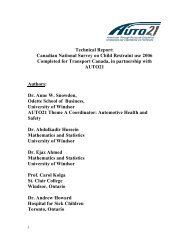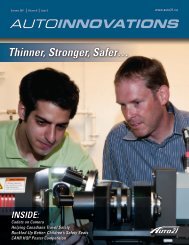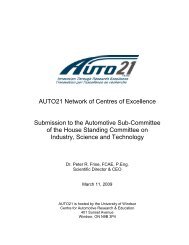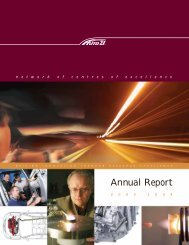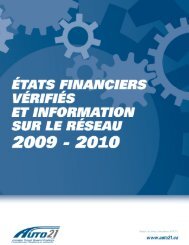Advances in Precision Sand Casting of Aluminum Engine ... - AUTO21
Advances in Precision Sand Casting of Aluminum Engine ... - AUTO21
Advances in Precision Sand Casting of Aluminum Engine ... - AUTO21
Create successful ePaper yourself
Turn your PDF publications into a flip-book with our unique Google optimized e-Paper software.
<strong>Advances</strong> <strong>in</strong> <strong>Precision</strong> <strong>Sand</strong> Cast<strong>in</strong>g <strong>of</strong><br />
Alum<strong>in</strong>um Eng<strong>in</strong>e Blocks<br />
Dr. Robert Ian Mackay,<br />
Nemak <strong>of</strong> Canada Corporation<br />
Dr. Jerry Sokolowski,<br />
University <strong>of</strong> W<strong>in</strong>dsor<br />
June 03, 2008
Agenda<br />
•The Problem: Durability <strong>of</strong> Alum<strong>in</strong>um Cast Eng<strong>in</strong>e Blocks<br />
•Cast<strong>in</strong>g Methods To Address Bulkhead Integrity<br />
•Alloy Chemistries: Subject <strong>of</strong> Research<br />
•Test<strong>in</strong>g Analysis & Results<br />
– ASTM 466-6<br />
– Staircase Fatigue Test<strong>in</strong>g<br />
2
Bulkhead Cyclic Loads<br />
LLT CA vs Bulkhead loads<br />
bulkhead loads<br />
45000<br />
40000<br />
35000<br />
30000<br />
25000<br />
20000<br />
15000<br />
10000<br />
5000<br />
Series5<br />
Series2<br />
Series3<br />
Series4<br />
0<br />
0 100 200 300 400 500 600 700 800<br />
crank angle
Fatigue Damage <strong>in</strong> Bulkhead Sections
Cast<strong>in</strong>g Methods To Address Bulkhead Integrity
Metallurgical Characterization <strong>of</strong> the 4.6L<br />
Eng<strong>in</strong>e Block Cast<strong>in</strong>g<br />
Bulkhead Section<br />
Identification<br />
A<br />
B<br />
C<br />
D<br />
Fatigue, Tensile and Metallographic Test<br />
Samples<br />
E<br />
Bulkhead Sections
Fatigue Environmental Test Chamber<br />
a b c<br />
d<br />
e<br />
f<br />
Figures a) – f) : a) Mounted fatigue test sample <strong>in</strong>side an environmental test chamber, b) Close up <strong>of</strong> the mounted fatigue<br />
test sample <strong>in</strong> high temperature 35 kN capacity grips, c) View <strong>of</strong> the mounted fatigue test sample <strong>in</strong>side the environmental<br />
test chamber and temperature controller, d) entire test frame and environmental test chamber, e) Load frame and<br />
environmental test chamber and f) Mounted stra<strong>in</strong> gauge test sample.
Rate <strong>of</strong> heat<strong>in</strong>g for the fatigue test sample and the<br />
environmental test chamber
Staircase Fatigue Test<strong>in</strong>g Methodology<br />
Failure<br />
σ 2<br />
Run out<br />
Mean Stress<br />
(Fully Reversed, R = -1))<br />
σ 1<br />
Δσ<br />
1 2 3<br />
Sample Number<br />
Three fatigue test samples at the beg<strong>in</strong>n<strong>in</strong>g <strong>of</strong> a staircase test. The sequence<br />
would cont<strong>in</strong>ue until the desired number <strong>of</strong> tests have been completed.
Effect <strong>of</strong> Alloy Chemistry<br />
• Freez<strong>in</strong>g Range (FR): Temperature gap between Liquidus (start <strong>of</strong> phase<br />
growth) and Solidus (complete alloy solidification).<br />
– Si: <strong>in</strong>creas<strong>in</strong>g its concentration shortens FR.<br />
– Cu: <strong>in</strong>creas<strong>in</strong>g its concentration lengthens FR.<br />
W319<br />
Alloy<br />
af s<br />
αDEN<br />
= 43%<br />
Hydrostatically<br />
Stressed liquid<br />
Alloy Si Fe Cu Mn Mg Ni Zn Ti<br />
WA328 9.17 0.372 1.02 0.159 0.310 0.185 0.145 0.076<br />
WB328 8.68 0.833 1.02 0.372 0.300 0.176 0.140 0.074<br />
WA328<br />
Alloy<br />
af s<br />
αDEN<br />
= 30%<br />
Less<br />
Hydrostatically<br />
Stressed liquid<br />
Pores
Example - 4.6L V8 Block<br />
(No chill with λ 2 = 55 mm structure)<br />
120<br />
Fully Reversed Stress (MPa)<br />
(R = -1, Operat<strong>in</strong>g Temperature = 120°C)<br />
110<br />
100<br />
90<br />
80<br />
70<br />
60<br />
50<br />
40<br />
30<br />
20<br />
10<br />
0<br />
Passed test (W319 with 70 ppm Sr)<br />
Failed test (W319 with 70 ppm Sr)<br />
Passed test (W319 with Gra<strong>in</strong> ref<strong>in</strong>er)<br />
Failed test (W319 with Gra<strong>in</strong> ref<strong>in</strong>er)<br />
Passed test (WA328)<br />
Failed test (WA328)<br />
0 5 10 15 20 25 30 35<br />
Sample Number
SEM/SE Micrograph <strong>of</strong> 4.6L V8 Block (WA328) Fatigue<br />
Test Sample #84,933,391<br />
#1<br />
Cycles, 75.8 MPa<br />
Transition l<strong>in</strong>e<br />
Pores<br />
1<br />
Shr<strong>in</strong>kage pores<br />
2<br />
200 μm<br />
#2<br />
3<br />
Interconnected<br />
Shr<strong>in</strong>kage pore<br />
1 mm<br />
(SEM/SE) micrograph taken from the fatigue test<br />
sample (sample # 8) fracture surface. The stress was at<br />
75.8 MPa & had a life <strong>of</strong> 4,933,391 cycles. The dashed<br />
boxes are shown at a higher magnification <strong>in</strong> Figures<br />
6.4.2l, 6.4.2n and 6.4.2p.<br />
200 μm<br />
#3<br />
Cracked Si Particles<br />
100 μm
Maximum Pore Diameter (μm)<br />
1000<br />
900<br />
800<br />
700<br />
600<br />
500<br />
400<br />
300<br />
200<br />
100<br />
0<br />
Relationship Between Porosity & HCF<br />
W319 (Al-5Ti-1B-10Sr)<br />
W319 (Al-5Ti-1B)<br />
af s<br />
αDEN<br />
Maximum Pore Diameter<br />
Mean HCF 4.6L W319 (In-furnace 70 ppm Sr)<br />
Mean HCF 4.6L W319 (In-mould Al-5Ti-1B)<br />
Mean HCF 4.6L WA328<br />
0 20 40 60 80 100<br />
Mean High Cycle Fatigue (MPa)<br />
WA328<br />
1.2<br />
1.1<br />
1<br />
0.9<br />
0.8<br />
0.7<br />
0.6<br />
0.5<br />
0.4<br />
0.3<br />
0.2<br />
0.1<br />
0<br />
Area Fraction Porosity (%)



